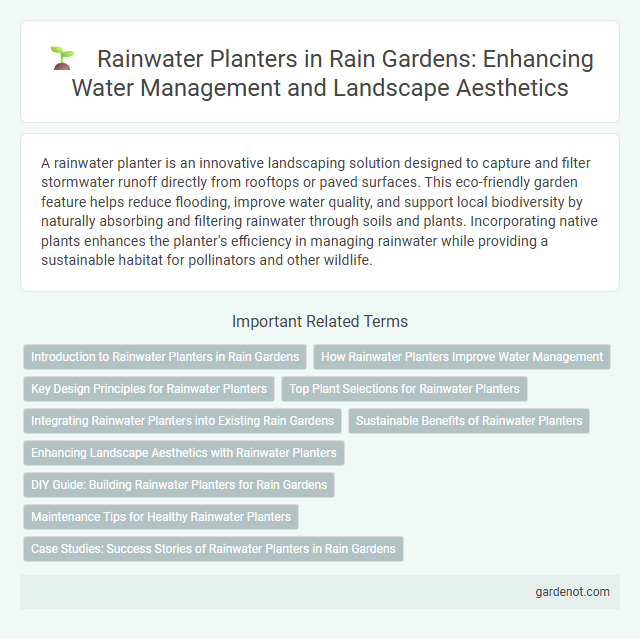A rainwater planter is an innovative landscaping solution designed to capture and filter stormwater runoff directly from rooftops or paved surfaces. This eco-friendly garden feature helps reduce flooding, improve water quality, and support local biodiversity by naturally absorbing and filtering rainwater through soils and plants. Incorporating native plants enhances the planter's efficiency in managing rainwater while providing a sustainable habitat for pollinators and other wildlife.
Introduction to Rainwater Planters in Rain Gardens
Rainwater planters in rain gardens are designed to capture and filter stormwater runoff, promoting natural infiltration and reducing urban flooding. These planters utilize native plants and engineered soil layers to enhance water absorption while improving water quality by trapping pollutants. Incorporating rainwater planters into rain garden designs supports sustainable landscaping practices and contributes to healthier ecosystems.
How Rainwater Planters Improve Water Management
Rainwater planters enhance water management by capturing and filtering stormwater runoff, reducing the burden on urban drainage systems and preventing flooding. They facilitate groundwater recharge through permeable soil layers, improving local water quality by removing pollutants and sediments. These planters also promote sustainable landscaping practices by conserving water and supporting native plant growth in rain gardens.
Key Design Principles for Rainwater Planters
Rainwater planters incorporate permeable soil mixes and native plants to maximize water absorption and pollutant filtration, ensuring efficient stormwater management. Proper slope, size, and overflow mechanisms are essential to prevent erosion and optimize water retention. Integrating features like organic mulch layers and underdrain systems enhances infiltration and supports sustainable urban drainage systems.
Top Plant Selections for Rainwater Planters
Top plant selections for rainwater planters include native species such as blue flag iris, swamp milkweed, and red-twig dogwood, which thrive in moist, well-drained conditions. These plants enhance water absorption and filter pollutants while providing habitat for local wildlife. Incorporating diverse perennials and grasses like sedges and ferns improves the planter's effectiveness and aesthetic appeal.
Integrating Rainwater Planters into Existing Rain Gardens
Integrating rainwater planters into existing rain gardens enhances stormwater management by increasing infiltration and reducing runoff. These planters capture and filter rainwater, promoting groundwater recharge and supporting native vegetation growth. Proper placement and selection of plants in rainwater planters optimize water retention and improve overall garden resilience against heavy rainfall events.
Sustainable Benefits of Rainwater Planters
Rainwater planters efficiently capture and filter stormwater runoff, reducing erosion and minimizing pollutants entering waterways. These sustainable systems promote groundwater recharge while supporting local biodiversity through native plant integration. Incorporating rainwater planters in urban landscapes contributes to climate resilience by mitigating flood risks and conserving potable water resources.
Enhancing Landscape Aesthetics with Rainwater Planters
Rainwater planters transform ordinary landscapes into vibrant ecological havens by incorporating native plants that thrive on collected rainwater, reducing runoff and promoting biodiversity. These planters enhance curb appeal through visually appealing designs that integrate natural water management seamlessly into garden aesthetics. Utilizing rainwater planters supports sustainable landscaping practices, contributing to healthier soil and flourishing urban environments.
DIY Guide: Building Rainwater Planters for Rain Gardens
Building rainwater planters for rain gardens enhances stormwater management by capturing and filtering runoff naturally. Start by selecting a shallow, watertight container with drainage holes, and fill it with a mix of native plants, sand, and compost to facilitate water absorption and pollutant filtration. Position the planter to intercept roof or driveway runoff, ensuring proper slope and overflow pathways to prevent waterlogging and maximize infiltration.
Maintenance Tips for Healthy Rainwater Planters
Regularly remove debris and sediment buildup from rainwater planters to ensure proper water infiltration and prevent clogging. Inspect plants for signs of stress or disease, replacing unhealthy specimens to maintain a thriving ecosystem. Mulching around the planter helps retain moisture and suppress weeds, promoting a balanced and healthy rain garden environment.
Case Studies: Success Stories of Rainwater Planters in Rain Gardens
Rainwater planters in rain gardens have demonstrated significant success in managing urban stormwater through notable case studies, such as the Seattle Public Utilities project that reduced runoff by 40%. These planters optimize infiltration and pollutant removal, promoting groundwater recharge and improving water quality. Studies also highlight their role in enhancing biodiversity by supporting native plant species and creating sustainable urban habitats.
Rainwater planter Infographic

 gardenot.com
gardenot.com